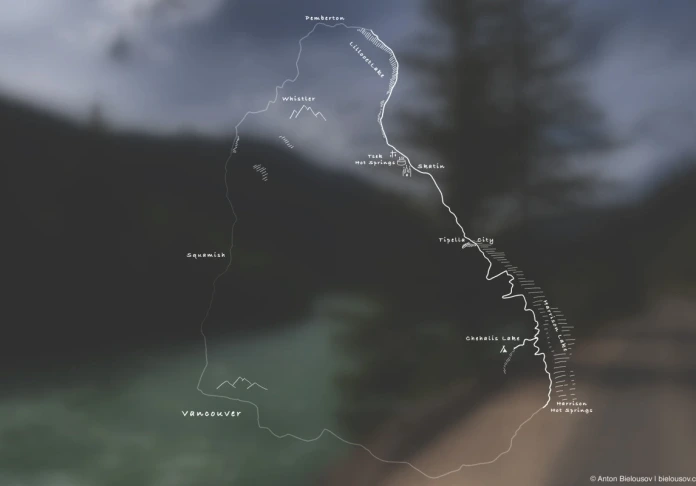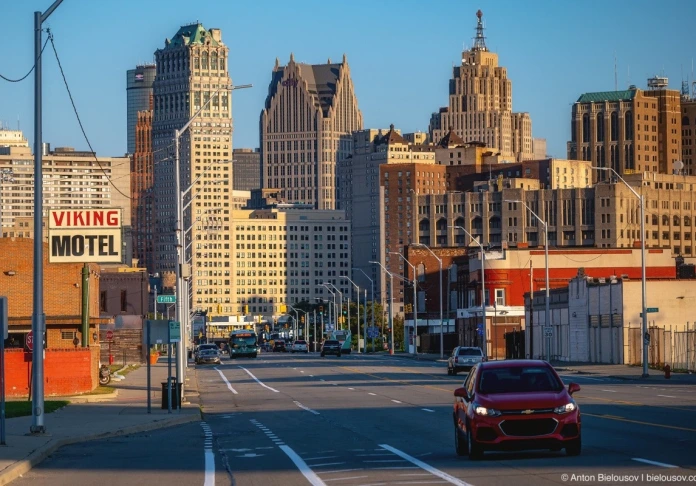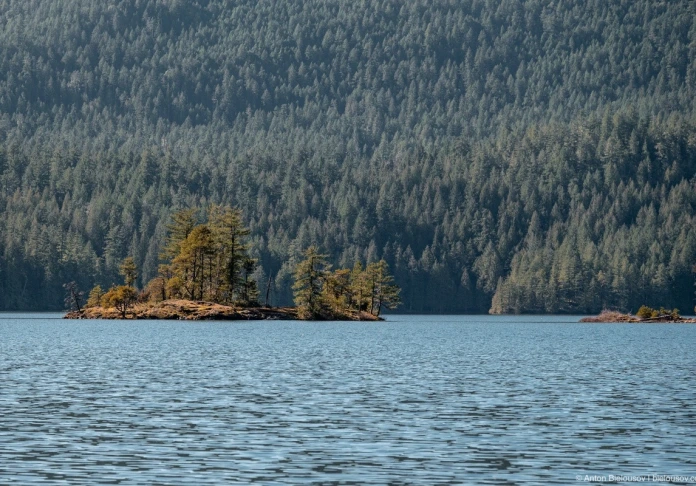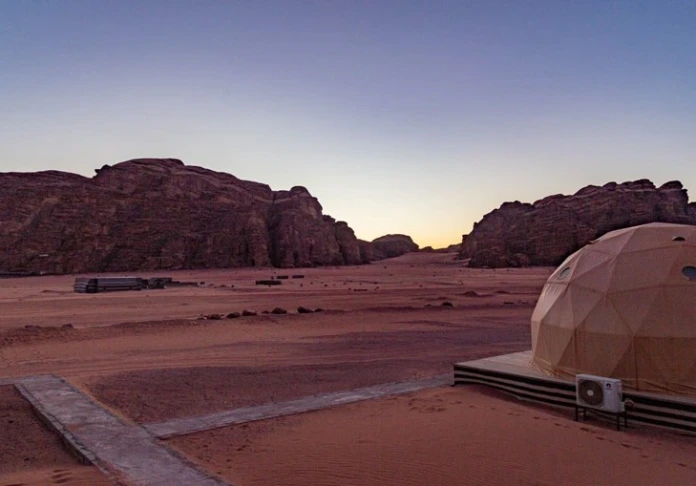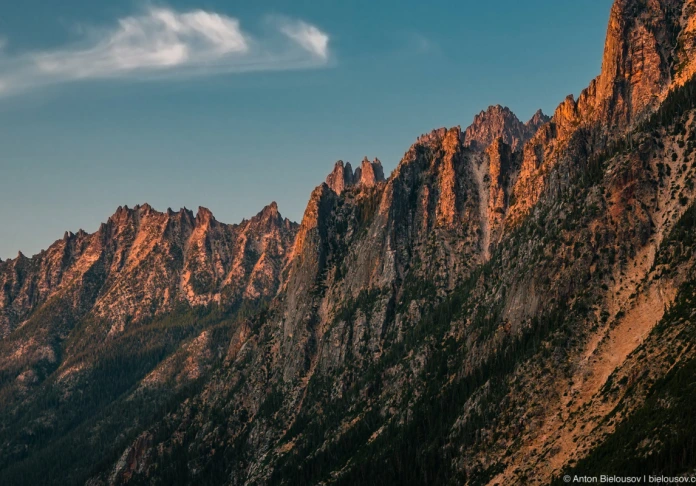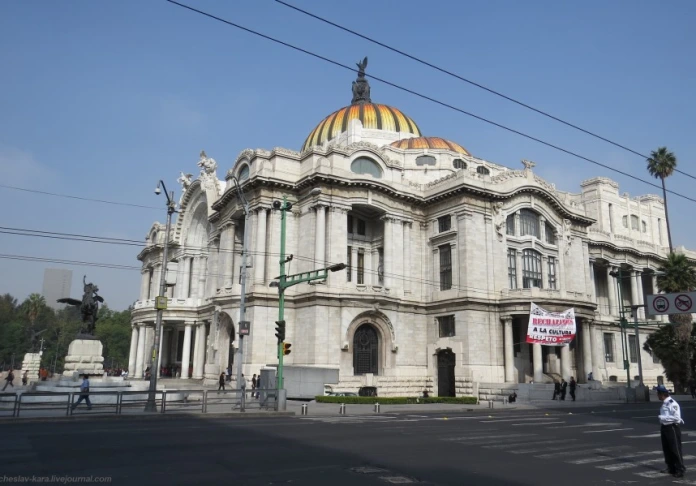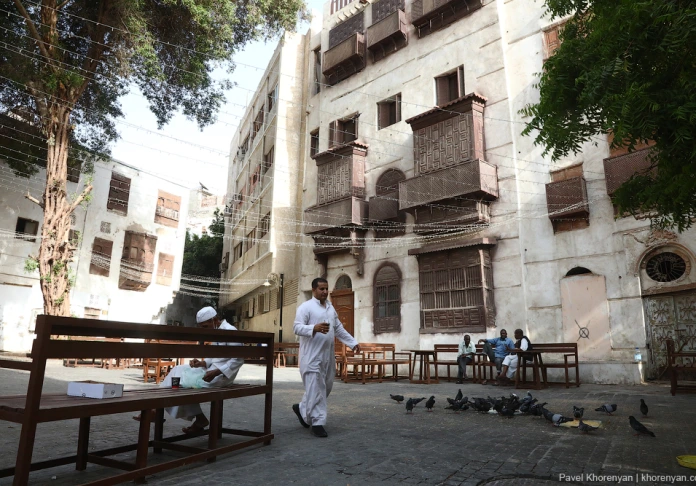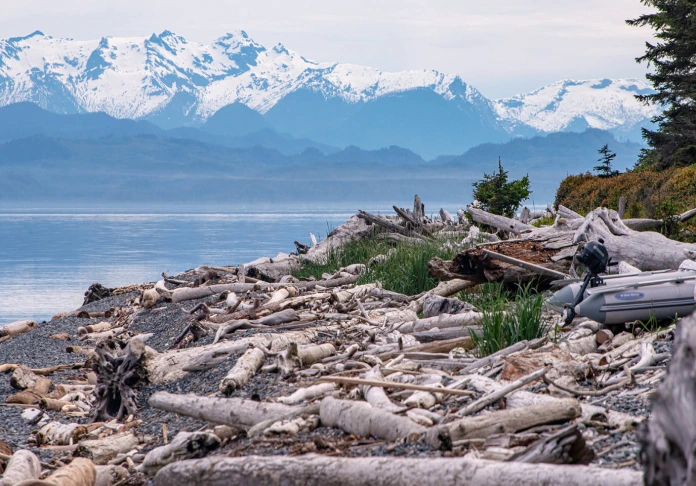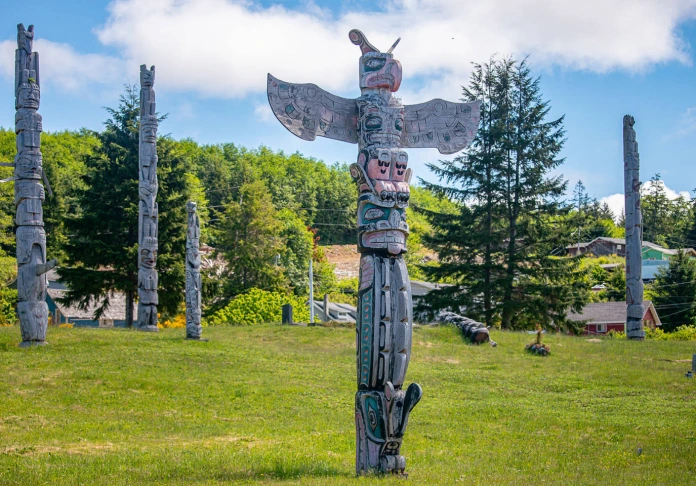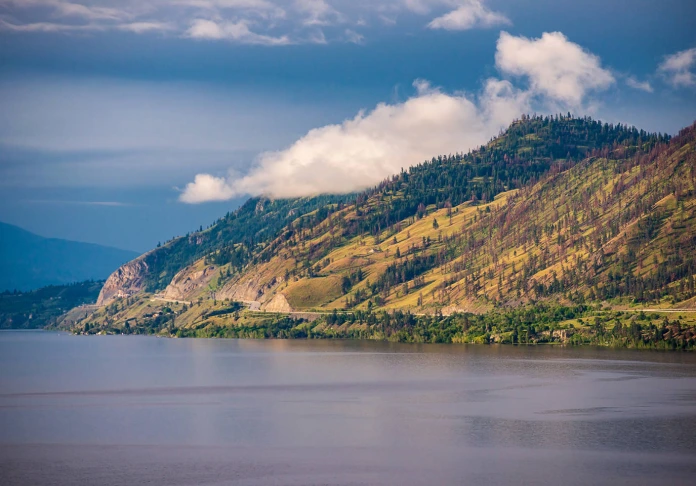Nice
My trip to the French Riviera began with Nice. In Nice, I flew on an airplane, and here we rented a room in a hotel, and from here every day we went to the next town along the Riviera. Of all the cities of Nice Côte d'Azur, with its 200,000 inhabitants seemed to me the most democratic, most youth and, simply, live. In Nice, I photographed quite a bit, so that today, under the cut - a compact overview report from the capital of the French Riviera.
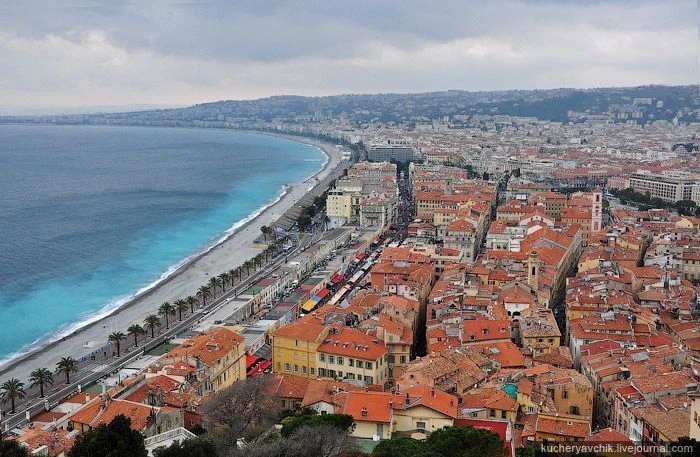
A general view of Nice.
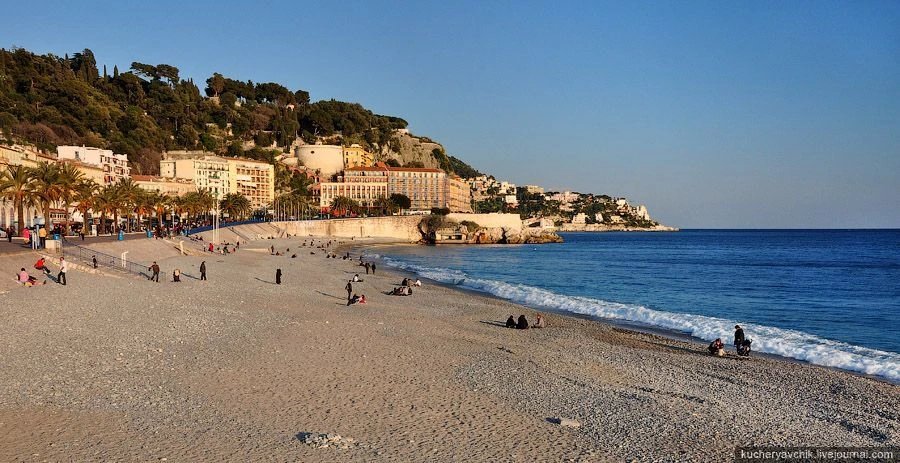
Playa de Ponshe and the rock on which formerly stood the fortress.
As Cannes, San Remo and Monaco, about which I wrote a few days earlier, Nice is also located near the cliff by the sea, where once upon a time there was a fortress. Nice castle was destroyed by the troops of King Louis XIV, when they won the Nice. Let me remind you that Nice in the 18th century belonged to the Duchy of Savoy, with its capital in Turin. The fortress was captured and destroyed by the French army, but soon returned to the Duke of Savoy. At the site of the ruins was later defeated a small landscaped park with an artificial waterfall and gardens. On the observation deck at the top of the cliff, you can see almost all of Nice, including semikilometrovuyu the Promenade des Anglais (Promenade des Anglais, Promenade des Anglais), which stretches from the central square of the city as much to the airport.
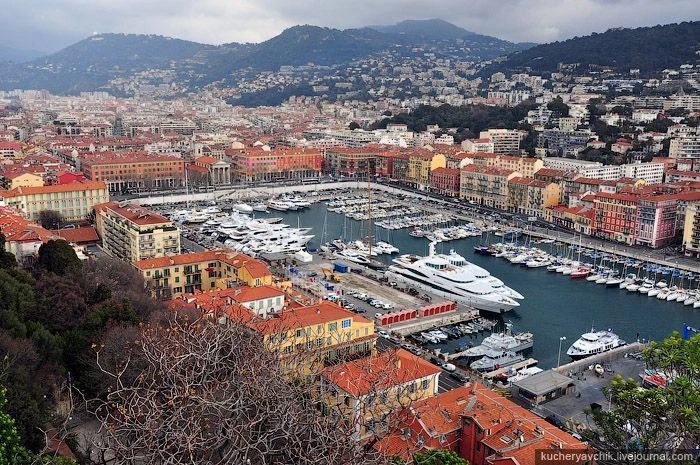
Nice harbor.
Quay is named after the British. Unexpected name for the street in France, is not it? Previously, when the Côte d'Azur is a long strip of Fisherman's Bastion and small fortresses, people preferred to settle away from the coast to avoid unpredictable floods. Embankments appeared in Riviera until the second half of the 18th century, when the Riviera acquired the status of an elite resort. Then in Nice and Cannes rushed the English aristocracy, who preferred to walk along the promenade and breathe the sea air. But this familiar to English travelers promenade in Nice was not! It was built after the devastating floods in the middle of the XIX century at the expense of British subjects living in Cannes. They strengthened the coastal strip of Nice out of sympathy for traders and poor, begging standing knee-deep in sea water. Since then, the British built a street called the English Promenade (Promenade des Anglais).
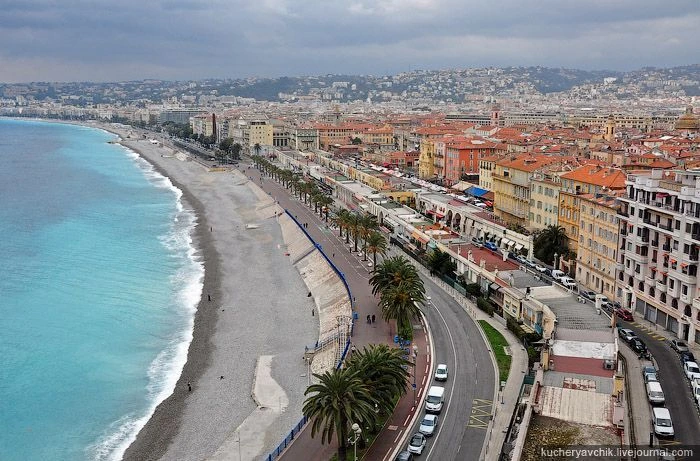
Nice view of the promenade.
On the one hand promenade ends at Nice airport - the second busiest airport in France after Paris airport Charles de Gaulle. On the other hand boardwalk crosses the main square of Nice - Place Massena (Place Massena), and goes to the United States Quay (Quai des Etats-Unis). At one of the houses at the beginning of the boulevard hangs a plaque dedicated to Abraham Lincoln.
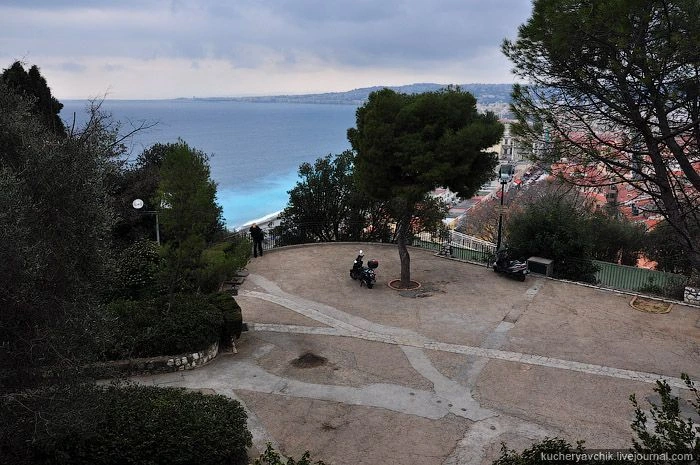
On the site of the destroyed army Louis XIV fortress appeared urban garden and cemetery.
Looking at Nice down, back into the city center. We will start a walk to the main square of Nice, Place Massena.
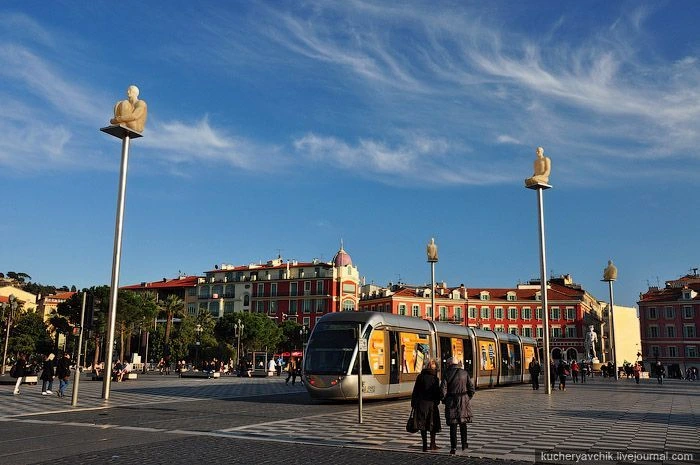
Place Massena - the central square of the town.
Note the trams: they go without the scissors! These trendy super-low floor trams and motor supertihim are made so that they can go on for some time batteries. Batteries are used when traveling through the main square. Here, in order not to spoil the appearance of the area have been removed all the wires and trams go to the accumulated charge. Tram stops around the corner, and raises the pantograph connected to the public grid. Fantastic technology, I saw a tram without a pantograph for the first time!
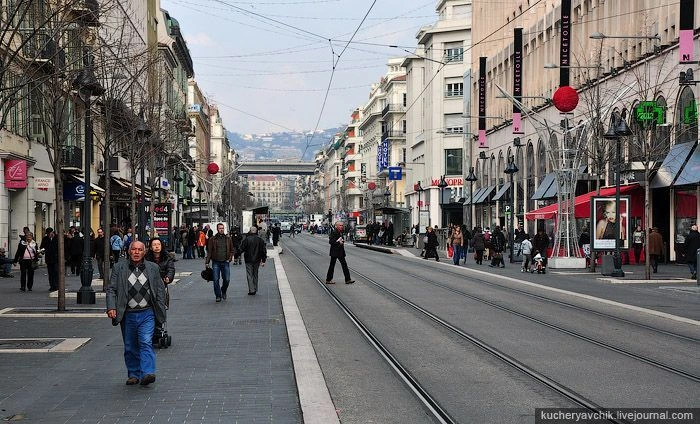
Ryu Madsen (rue Medicen) in the center of Nice. There are shops and restaurants.
Located in a valley between the mountains and the Mediterranean Sea Nice years represents only a small settlement. Since then, the city of far remained a small block of old buildings. Houses in this quarter resemble Italian than French city. In connection with the fact that Nice until 1860 was part of the duchy of Savoy, whose capital was Turin, Nice has developed in the Italian cultural environment and the city's architecture reflects the Italian way of life. Until now, the dominant cuisine in Nice - Italian, French cuisine restaurants in the city quite a bit.
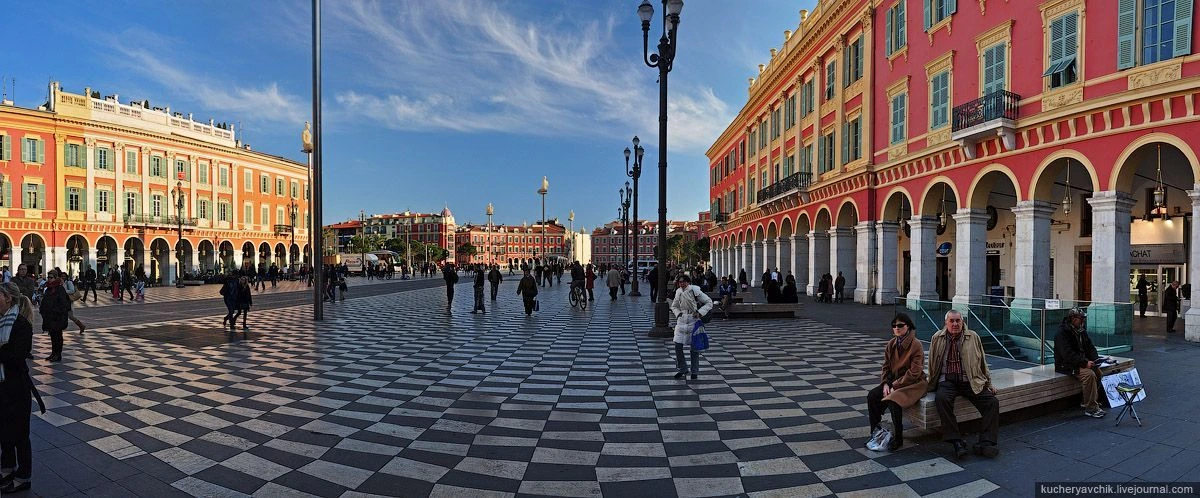
Panoarmny view of Place Massena.
So Nice is the latest acquisition of the French Republic, when the city was given to the first king of Italy, Vittorio Emmaniulom I in gratitude for the support of the French army of the war for the unification of Italy. In this war, the King of Sardinia and Savoy fought for the crown of a united Italy, and the French army supported him in this. In gratitude for the military support of the Duke of France presented part of its territory around Nice and the city itself, because I thought them to be insignificant for Italy. So native Italian city became French, and presented to the accession of the territory of the Duchy of Savoy in 1860, remains the new territorial acquisition of France until today. Ironically, the main character of this war and the immortal symbol of Italy, Giuseppe Garibaldi, was buried in Nice, that is, after his death, he was outside of his homeland.
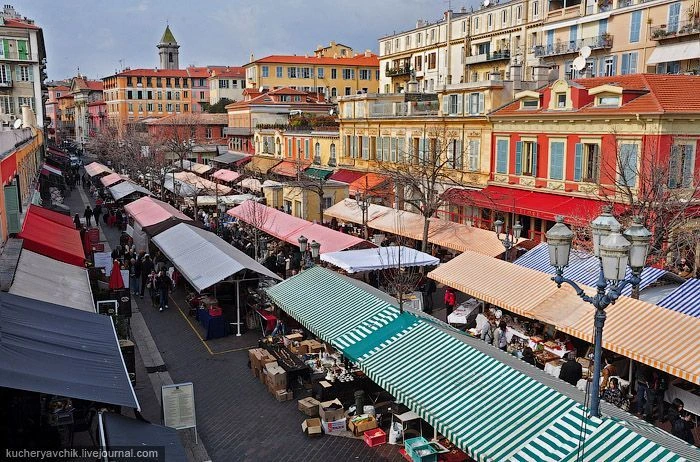
Flea market on the Cours Saleya.
In the old center of Nice is Cours Saleya (Cours Saleya), which is held in the center of the traditional flower market. On Monday, the flower market gives way to a flea market. On the same square is the old town hall (?) And the police department.
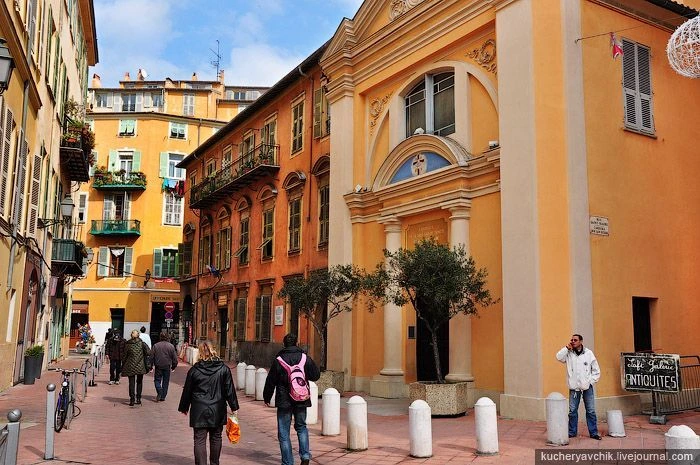
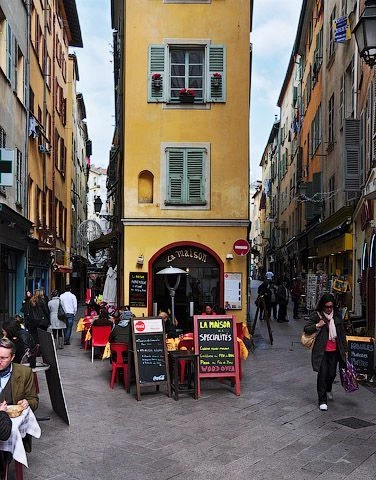
Nice old quarters reminiscent of Italy.
On the narrow alleys of the old city of Nis Vё (I correctly said Vieux Nice?) Are souvenir shops, artists studios, shops and restaurants and ice cream mussels. Showcases look nice, the menu sounded delicious, ice cream smells like fruit.
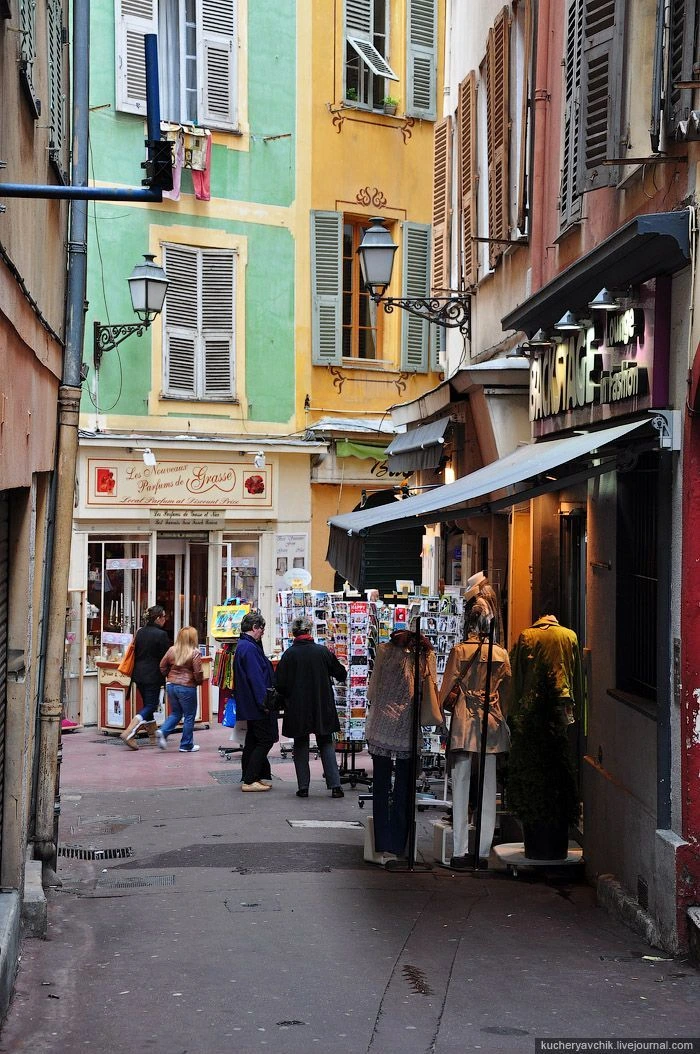
After Cote d'Azur became popular among European aristocracy during the second half of the 19th century (the popularity that the resort has not lost so far!), The architectural appearance of the city has undergone great changes. In Nice, there boulevards along them were built luxury villas and a little less luxurious apartment houses. Historical buildings in Nice, on the whole, well preserved, except, perhaps, the waterfront. Among the houses on the Promenade des Anglais dominates the functional architecture of the 1970s, with a few exceptions for a few old buildings.
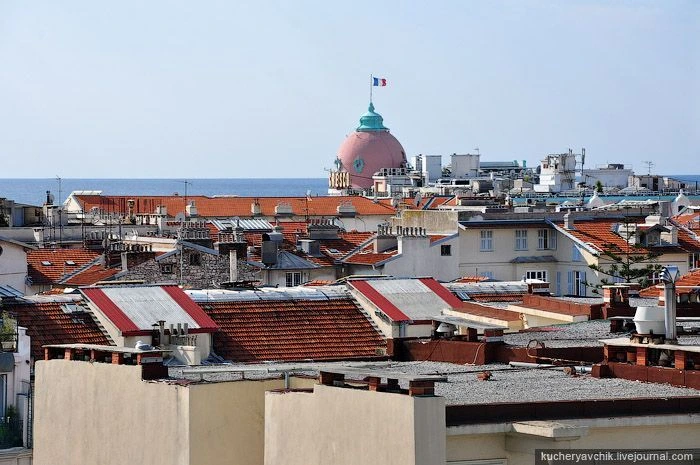
A dome over the houses of the hotel "Negresco" - the most famous buildings in Nice.
The most famous building in Nice is still on the same Promenade des Anglais. This - the hotel "Negresco", built in 19hh year and named after its founder. Henri Negresco, a native of Bucharest, arrived in France at age 15 and got a job. His career led him to the position of Managing Casino in Nice. Over time, decided to open his own Negresco hotel in Nice, which would become a symbol of luxury for the rich. He invited the architect Edward Niemann (Édouard Niemans), the dome of the building work engineering office Gustav Eyffelya (Gustave Eiffel). Hotel waiting stunning success, but just before the First World War. European countries have declared war on each other, and closed the borders. As a result, the hotel quickly went bankrupt, and its founder was vynuzhedn to sell the hotel to make ends meet, but his name remains in the memory thank the hotel, which is now the main attraction of the town.
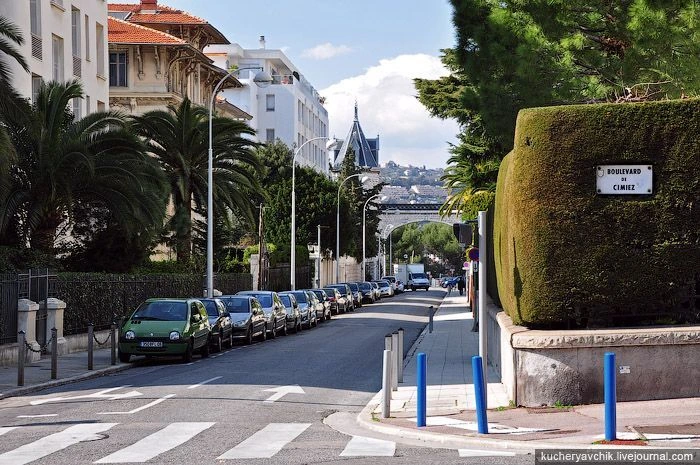
One of the streets walks away from the Boulevard de Simiez.
A little bit away from the promenade and the central area to the north of the city extends Boulevard de Simiez (Boulevard de Cimiez). Long boulevard climbs mountains and passes through the area of luxurious mansions late XIX-early XX century. At one time, on this boulevard lived some of the most influential and famous Europeans.
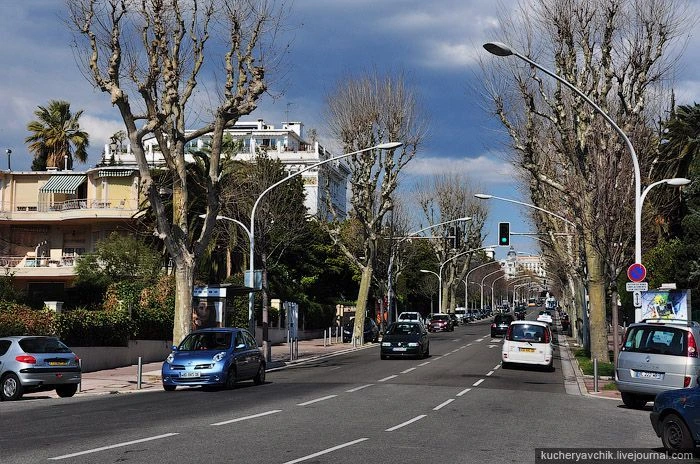
Perspective Boulevard de Simiez. In the distance you can see the building of the hotel "Regina".
At the beginning of the boulevard winds several times and crosses the highway A8 Marseille Menton. On the Italian border highway turns into the A10 motorway, the so-called "road of flowers" ("Autostrada del Fiori").
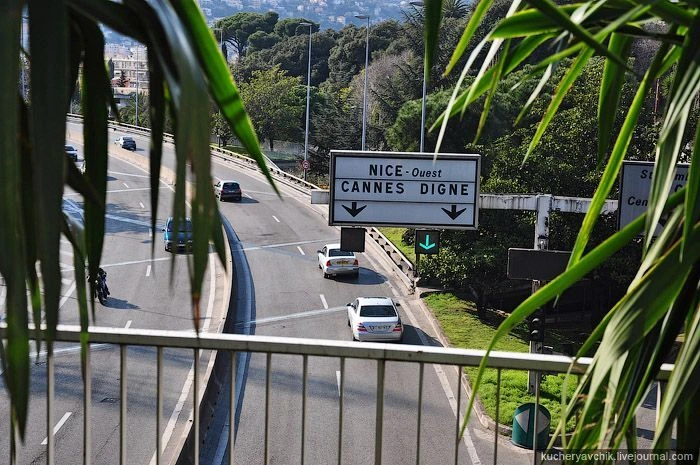
Car A8 passes on the overpass over Nice.
After crossing the road car, we find ourselves in the area Simiez (Cimiez). On both sides of the boulevard located mansions of different tastes and years of construction. There is the classic style villa "Belle Epoque", and a more modest home 1920-30s, and big, just huge apartment buildings and hotels.
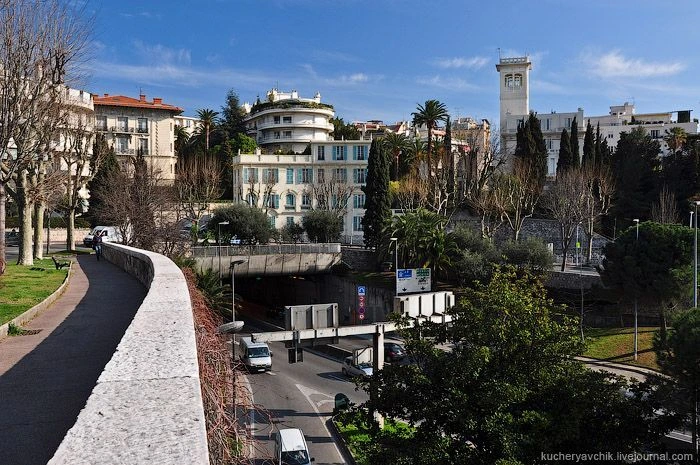
On this stretch of highway entrance to the tunnel, on which are located were once very prestigious home. Some houses in the vicinity of the motorway abandoned, as because of the noise of the incessant flow of automobile live here is almost impossible.
Before you continue along the boulevard Simiez, we will turn to the left. There is a museum of the biblical message of Mark Chagall. The museum is worth a visit, even those who are not versed in the art. In 1970, Marc Chagall Nice gave 12 of his works on biblical subjects. The paintings are made in an easily recognizable style Chagall and devoted to different stories from the Old and New Testament. All paintings are exhibited in the central hall of the museum, in the other rooms are the sketches and later acquired by the museum. The building itself deserves special mention. It was designed by Israeli architect whose name I could not find. A small garden separates the museum from the noisy streets.
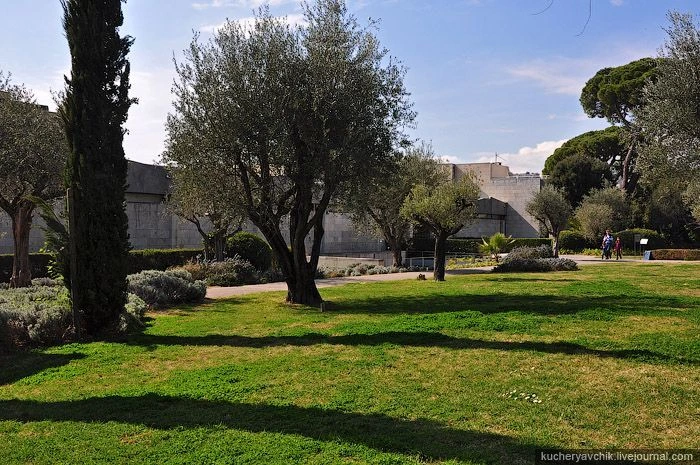
In the courtyard of the museum Marc Chagall.
Permeated work of Marc Chagall, can continue to leisurely ascent along the boulevard Simiez towards the ruins of the ancient Roman fortress.
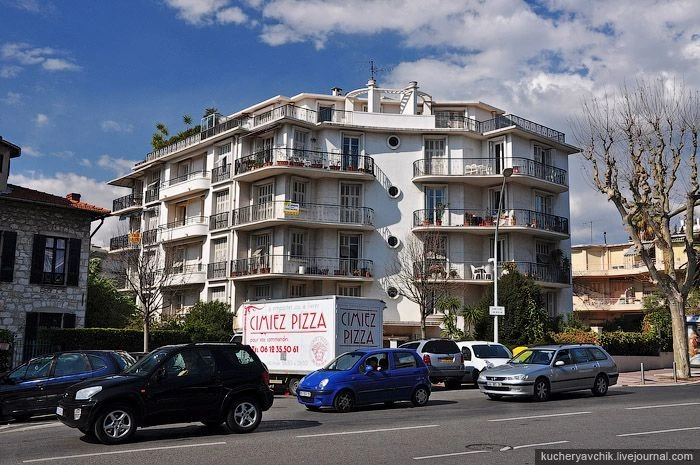
On both sides of the boulevard we find mansions and houses of different eras.
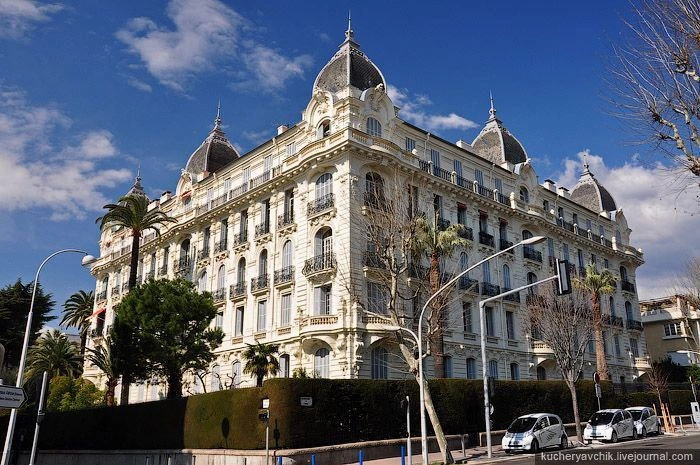
In Nice, lived the cream of European society of the late 19th century. Among others, somewhere on the Boulevard de Simiez lived a Paul G. von Derviz, whose company was the main contractor for the construction of the railway in the Russian Empire. Background Derviz efforts were connected railroad tracks Moscow, Kursk and Kiev. Not surprisingly, the railroad magnate paid for the delivery of wooden huts of his estates near Kiev. The cottage has been installed in the garden of his villa in Nice, he said, reminded him of home.
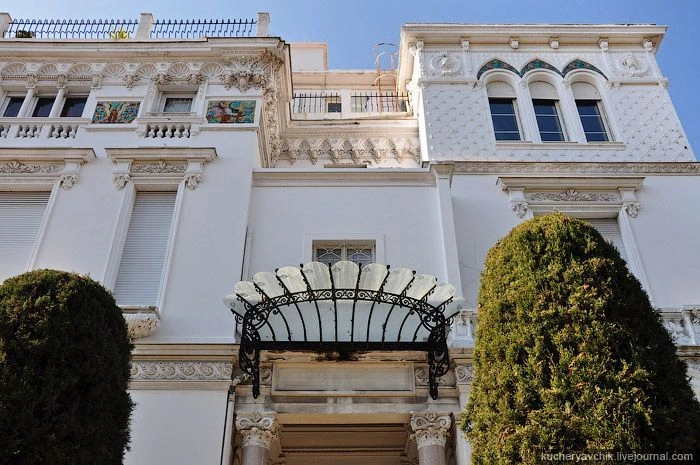
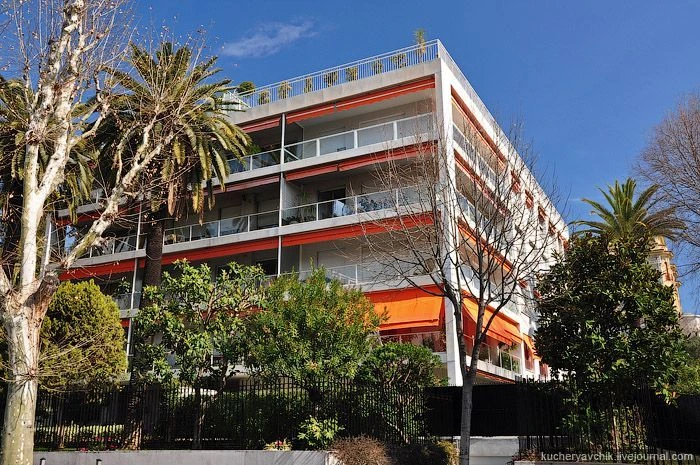
Toward the end of the boulevard is a hotel "Regina" - one of the largest hotels in Nice. I personally do not like the building because of glazed balconies, plastic windows and modern add-ons. In general, it is fair to say that in Nice prevails very pragmatic attitude to historical buildings. Apartment houses are built with a light hand for a couple of floors "in a similar style," the old buildings, the value of which is not attested to visit the outstanding figure of European politics or art, giving way to a new apartment houses. Demand for accommodation in Nice is stable, and the cost of real estate - fabulous.
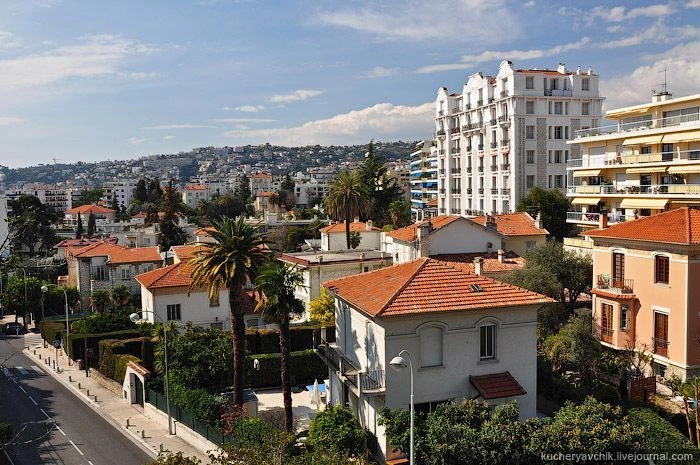
As can be seen, the architecture of Nice is the raznoboraznaya.
In the "Regina" stayed many influential people of the Old World. At the time, spend the night here, even Queen Victoria. The Queen always slept alone in his bed, so for her to "Regina" brought and installed her personal bed of London Palace. From the windows of the huge building "Regina" offers a beautiful view of the city.
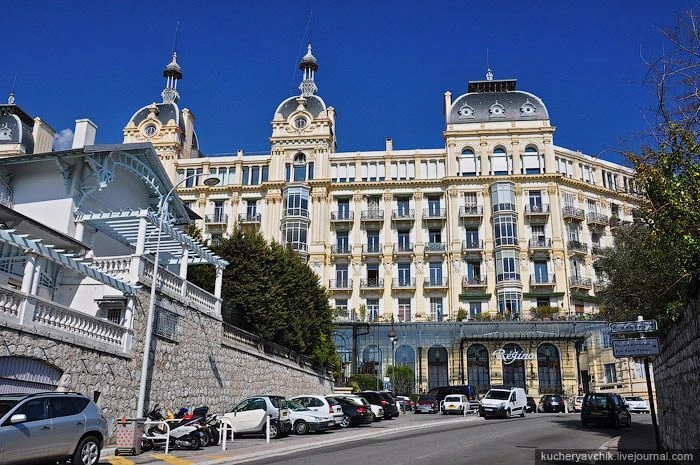
Hotel "Regina".
Next to the "Regina" on display ruins of the Roman city. Nice was founded by Greek colonists in 350 BC The Greeks called their city of Nicaea in honor of the goddess of victory Nike, and hence the current name of Nice. With the expansion of the Roman Republic, the Greek colony in what is now the south of France came under its control. The Romans built on the hill above the present city fortress Cemenelum. The ruins of the capital of the region of Marine Alps (Alpes Maritimae), together with the remains of the ancient Roman amphitheater can be found in the park Simiez. In this park every July Jazz Festival.
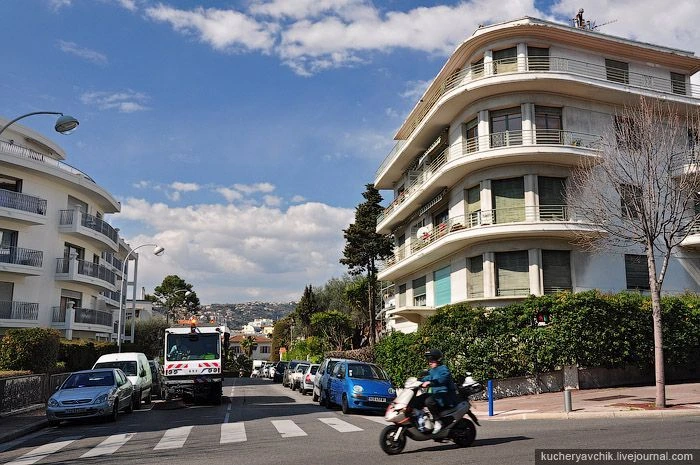
Incidentally, the name of the administrative region of Alpes Maritimes preserved since the Roman Empire, when Octavian Augustus identified this area as a separate province. As 2000 years ago, the capital of the region is located in Nice.
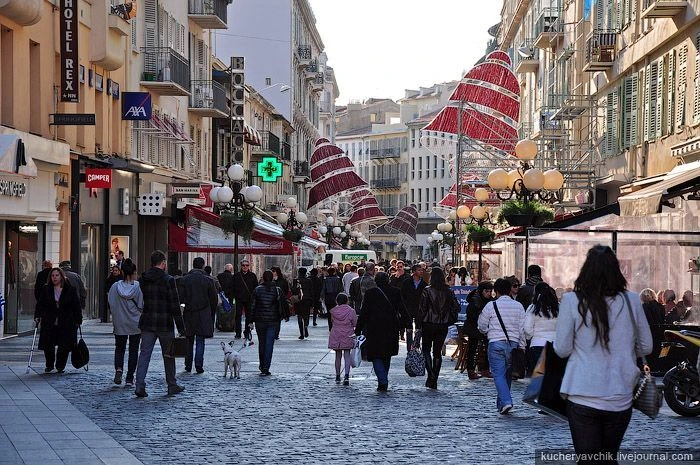
Rue Massena goes to the Massena Square, the main square of the town.
Near the ancient remains of the park is a museum Simiez Matisse. French modernist painter second half of his life spent in Nice. After the death of his collection became the property of the city. Since Matisse was an acknowledged master of the brush during his lifetime, his paintings were sold successfully. What is not sold out during the author's lifetime, was donated to the museum in Nice. Entrance to the museum is free, and a collection of works - very unrepresentative for this author. Believe my words, Matisse Museum in Nice, you can safely skip. Nice - great fun city where you can easily spend a few days. Depending on the interest you can walk to the shops, breathe the sea air on the Promenade des Anglais, climb to museums or roam the flea and flower markets. Nice attracts tourists, first of all, a perfect location in the city has an international airport, railway station node, the port from which ferries to Corsica, and even a helipad for those who wish to fly to Monaco by helicopter. Due to the huge number of hotels, find accommodation in Nice is not too difficult. Nice - the perfect city to him to begin studying the Côte d'Azur.

